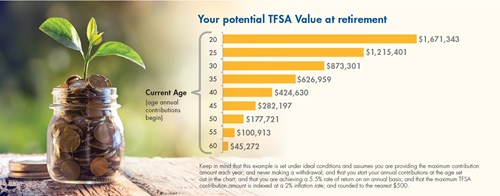The simple truth is that money accumulates over time. It does not get handed to you, despite what you may see on TV. For many of us, it is not about windfalls or lottery tickets, it is about being committed to investing over the long-term.
The Tax-Free Savings Account (TFSA) can be a misunderstood savings tool. Considered by some to be a short-term investment, many of us do not value its long-term savings potential. You may be surprised to know, a TFSA can hold term investments, mutual funds and individual securities like stocks and bonds. Equitable’s Pivotal Select™ segregated funds and Guaranteed Interest Accounts also make excellent choices for TFSAs.
A powerful savings tool during your working years. When you invest in a TFSA, did you know:
- You are never taxed on the growth you
- You are not taxed when you make a
- If you are at least 18 years old, you earn new contribution room every
- Contribution room is cumulative, you can make extra deposits if you have not maxed out in previous
- If you make a withdrawal, your contribution room is regained the following
A powerful savings ally during your retirement years. At retirement, many Canadians rely on income from a pension plan or Retirement Savings Plan (RSP). An alternative source of tax-free income like a TFSA can also be beneficial. A TFSA allows you to draw income when you need it.
When using a TFSA in retirement, did you know:
- Withdrawals from a TFSA do not affect your eligibility to receive Old Age Security, Guaranteed Income Supplement, Goods and Services Tax/Harmonized Sales Tax credit or other income-tested benefits and tax
- Unlike an RSP, a TFSA does not need to be converted to an income product at age
- Your estate is not burdened with a hefty tax bill upon your death, often the case with an RSP.

Still not convinced about the power of a TFSA, consider this! While this example may not apply to everyone’s situation, it does show the potential value a TFSA can offer as a long-term savings plan.
Keep in mind that this example is set under ideal conditions and assumes you are providing the maximum contribution amount each year; and never making a withdrawal; and that you start your annual contributions at the age set out in the chart; and that you are achieving a 5.5% rate of return on an annual basis; and that the maximum TFSA contribution amount is indexed at a 2% inflation rate; and rounded to the nearest $500.

